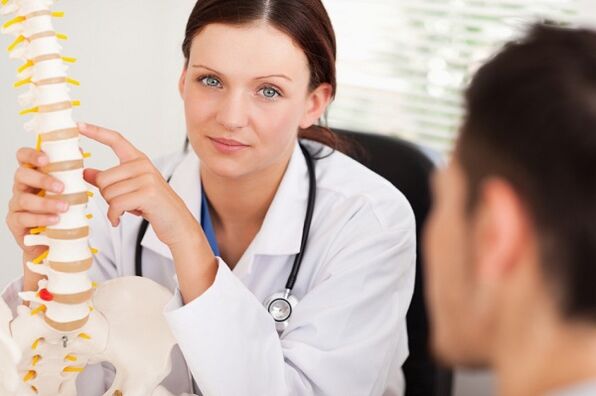Another serious disease of our time is osteochondrosis. His first activity could appear as early as his youth, when he sat in front of a computer or in front of a notebook for a long time, suddenly moving in the driver’s seat. Most become such that the head is difficult to turn or "lift" off the pillow. After a few days, the exercise usually passes, and it can take several months until the next arrival, and there may be a flight. Don't be fooled though! The first thing is a serious warning that the mechanism of disruptive disruptive changes in your organization is already in place. To understand this, let’s understand what osteochondrosis is and why you need to start treating it with the first symptoms.

What is osteochondrosis?
Osteochondrosis is a complex dystrophic change in the spine, in which the following stages can be distinguished:
- Dystrophic changes in the cartilaginous tissue of the intervertebral discs, as a result of which movements are limited and cause a feeling of discomfort (phase I)
- Disc deformity and gradual decrease in intervertebral distance (phase II).
- Disc herniation formation (phase III)
- Formation of the spine (osteophytes) and ossification of the ligaments, making movement very difficult and painful (phase IV)
Hernia education is a difficult process that will be dedicated to entire sections. However, by now you should know that such a serious disease will occur if the phenomenon cannot be treated at the right time. Therefore, if you had an idea of such a herd, let us describe it in two words. For this it is necessary to turn to the anatomy again and remember the device of the spine and spinal disc.
Spinal disc dystrophy leads to the weakening of its fibrous ring and the displacement of the amber of the disc head (core), as a result of which it is released.
In order to identify the presence of osteochondrosis, especially in other stages, when the exclusion of these explicit external signs, as well as to determine its intensity and degree, it is necessary to make a magnetic difference in human diagnosticity. allows you to pinpoint the angle. Based on the doctor's description and MPT recordings, the specialist will make the correct treatment plan for the patient, which is safe and healthy.
Types of vertebral osteochondrosis
Osteochondrosis is of several types
- Cervical neck - the most common, because it affects both young and old.
- Thoracic - is relatively rare.
- Lumbar - developed after 40 years.
- Sacral - usually passes from the lumbar.
- Widespread - affects several departments or even the entire spine.
Spontaneous development of this disease often occurs in the same sequence: starting from the upper cervical vertebrae to spontaneous and spontaneous.
But it happens that the type of osteochondrosis is related to human activity. Thus, the cervix usually spreads among students, contractors and all other exhibitors of "brain" occupations, although some of them have a long cervix. "cidyachih" cpetsialnoctey - kpectcyyy kpectcyyy kpectcyyy kpeccnыyBustal occultation is also often observed in those who are on their feet almost all day, because this one stays on the ground in the middle of war.
Reasons for the appearance and development of osteochondrosis
However, osteochondrosis is not just a disease of a sedentary lifestyle, improper posture, or the consequences of lifting weights. There are many more factors and reasons for the development of this disease.
Let's highlight only the main ones:
- Improper diet with insufficient amount of protein and high content of sugar and fat.
- Metabolism and hormonal imbalance.
- Infectious diseases.
- Hypothermia.
- Increased weight and obesity.
- Spinal cord injury.
- Age-related bone degeneration.
- Hereditary diseases.
- Stress.
The main symptoms of osteochondrosis
Cervical osteochondrosis:
- Pain in the neck and head (may give under the shoulder blade, in the sternum and arm).
- Dizziness, especially when changing head position.
- Numbness in the neck, face, tongue, subscapularis.
Chest osteochondrosis:
- Chest pain that can be increased by inspiration and movement.
- Feeling of numbness in the chest.
Lumbosacral:
- Pain in the groin area (may be painful or acute) radiates to the legs, and the localization of pain in the legs can range along the entire length of the limbs.
- Paresis of the legs (violation or even loss of sensitivity).
The pain in osteochondrosis is of a specific neurological nature. Thus, people tend to accept headache, dizziness, numbness, or leg pain as direct manifestations of head or leg disease, although these may be symptoms of vertebral osteochondrosis. Therefore, if you notice something alarming in your health condition, which coincides with the above signs, be sure to visit a neurologist. After the doctor's examination, if this disease is suspected, he will definitely prescribe an X-ray examination.
The main methods of treatment of osteochondrosis
Before treating osteochondrosis, you must first eliminate the causes of its occurrence.
The most effective relief of back pain:
- Therapeutic gymnastics (exercises for back pain).
- Laser MLS (after the 2nd session the pain disappears).
- Khivamat (a unique procedure that immediately relieves pain, but you have to walk 2-3 times. )
Just removing the cause of osteochondrosis progression is also the main method of its treatment and prevention.

Prevention and treatment without drugs
This is primarily:
- Active (mobile) lifestyle and sports.
- Normal foods with a protein diet that excludes fats and sugars.
- Physiotherapy (exercise therapy) with an individually selected series of exercises for each type of osteochondrosis.
- Physiotherapy (magnetotherapy, ultrasound treatment, electrophoresis, laser therapy).
- Massage, manual and reflexology.
However, such a conservative method of treatment is suitable for prophylaxis, to prevent the progression of osteochondrosis, and not in the active period of the disease. But how to treat this disease, if it is ongoing, its manifestations are obvious and the person has a stage of exacerbation, namely:
- pain and fever;
- limited, difficult movement.
In this case, exercise therapy and physiotherapy are categorically contraindicated and only treatment methods are used.
Drug treatment methods
First of all, it is necessary to stop the pain and alleviate the inflammatory process in the irritated nerve root. For this purpose, the following have been appointed:
- nonsteroidal anti-inflammatory drugs (NSAIDs);
- steroidal anti-inflammatory drugs - corticosteroids, glucocorticoids;
- novocaine blockade (with severe pain);
- muscle spasm medications;
- ointments, gels and painkillers.
The second phase of treatment includes:
- Use of vasodilators: osteochondrosis always coexists with vasoconstriction and oxygen starvation of the brain (hence headache and dizziness).
- Naming drugs that calm the nervous system: patients with this disease are always worried and suspicious, in most cases they are very scared of the first attacks of the disease.
- Treatment of side effects - can be hypertension and heart dysfunction.
- Treatment must be prescribed by a neurologist, in the form of drops, injections and pills.
Do not try to cure the disease yourself!
At the end of the acute period and the normalization of well-being, return to preventive methods of treatment without drugs: exercise therapy, massage and physiotherapy-in the absence of contraindications.
Health to you!
































